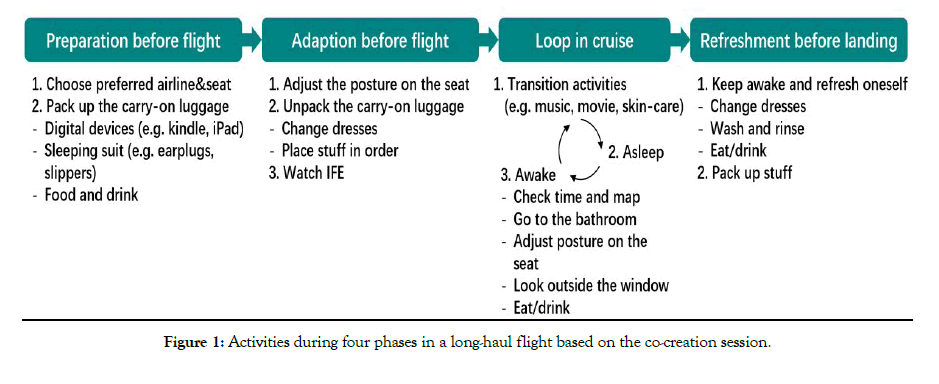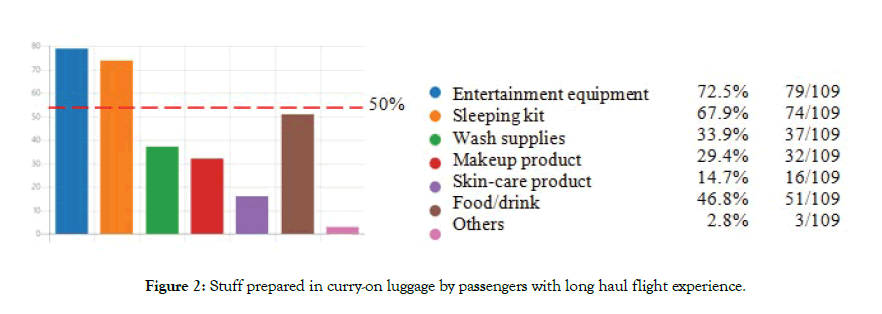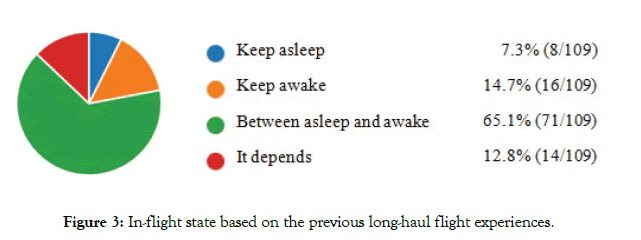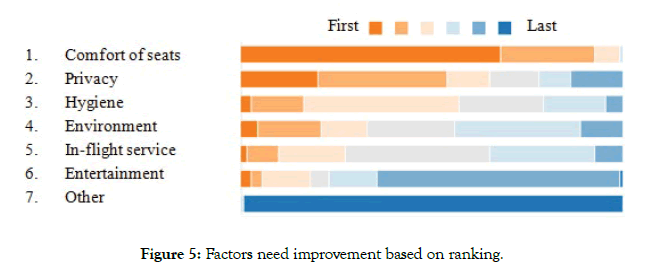Journal of Ergonomics
Open Access
ISSN: 2165-7556
ISSN: 2165-7556
Research Article - (2020)Volume 10, Issue 3
Sleeping in long haul flights is difficult. There is noise, an upright sitting position and neighbours and crew disturb the sleep. However, there is not much information available for designers on the most important factors next to the seat that could improve the sleep quality. In this paper a co-creation session and a survey among 109 participants has been performed to study factors influencing sleep in a long-haul flight. This study shows that not only the seat is important for a good sleep, but factors like privacy, hygiene and neighbours play a role as well. The more frequent travellers experience more comfort during sleep. So, probably a good preparation is important as well.
Aircraft; Psychological discomfort; Anthropometrics
Sleeping in long-haul economy class flights is certainly not comfortable. Bouwens et al. studied comfort in airplanes and found that in long-haul (6-12 hours) flights nearly 80% of the passengers do sleeping [1]. They also showed that sleeping had the lowest comfort score among the activities: sleeping, being bored (doing nothing), gaming, walking, reading, taking away garbage, watching IFE (in-flight entertainment), listening to music and eating/drinking. This discomfort during sleep is probably caused by noise and the upright sitting position. However, also neighbours and crew might disturb the sleep. There is not much information available for designers on the most important factors next to the seat that could reduce discomfort during sleeping. The ideal posture for sleeping in a seat has been described Stanglmeier et al. but it is completely different from the current position in economy class seats [2]. The paper of Tan et al. affirms that both physiological and psychological discomfort, even stress and health risks appear while sleeping in the aircraft [3].
Apart from discomfort during sleep, there are many factors influencing sleep quality for passengers, consisting of both physical elements and experience elements. These elements were studied by Dumur et al. [4]. The factors seat (anthropometrics), smell, noise, vibration, light and climate influence sleep quality as well Bouwens et al. with the seat as the most important factor [5]. In 2000, British Airways was the first to introduce the flat bed in the business class which was copied by other airlines [6]. For economy class this is not introduced (yet). However, next to the seat other factors influencing sleep quality, like the neighbour and service provided by crew could be important as well.
For designing an aircraft interior, in-depth data about the service provided and other interactions with the passengers could be helpful to make the design more passenger-specific. The research question for this study is:
What are factors in a long-haul flight mentioned by passengers that influence sleeping quality in different phases of the flight?
Co-creation sessions and a survey were used to answer the research question. Three rounds of co-creation sessions were used with 14 students (age 21-28 years) who all flew more than four times long-haul (6-12 hours) [7]. Each round lasted for approximate 60 minutes, involving 4-5 participants and one moderator. After welcoming and introducing the participants and asking them to read and sign the consent form, the participants were sensitized with an immersive video of background white noise and clipped videos of long-haul flight from the internet [8]. Participants were asked first to draw or write down their experience in a timeline and their opinion on tangible parts in the interior. Then, they were encouraged to add their emotions and document reasons on colour-coded stickers. After this, more in-depth data were gathered in an interview.
The completed paper forms were gathered and compared, and collective patterns among the 14 experience reports were identified. A transcript from audio recording was clustered by high-frequency words.
The survey was a questionnaire in two languages (Mandarin and English) and published online by Microsoft Forms. It consisted of single-choice questions, multiple-choices question, open-ended questions and rankings. 219 participants (80 males, 139 females), aged from 20 to 66 (average 38.2, SD 12.6) completed the online survey. 49% participants (106) never took a long-haul flight, 22% participants (48) flew more than four times long-haul, the rest of them (61) less. 91% of the participants was from mainland China, others from all over the world.
In the data analysis invalid answers were removed. The 215 complete answered questionnaires were captured in Microsoft Forms. To verify whether there is a significant difference between expectations of experienced and inexperienced passengers, a t-test was done and the p-value was calculated using Excel.
Results: co-creation session
In the co-creation session four phases and activities related to inflight sleep could be distinguished (Figure 1): preparation before the flight (e.g. pack an in-flight amenity kit, selecting seats), install after boarding (e.g. adjusting the sitting posture), cruise flight (asleep/ awake/transition), refreshment before landing (e.g. washing face, changing dresses).

Figure 1: Activities during four phases in a long-haul flight based on the co-creation session.
Before the flight, participants have relatively positive emotions, like getting excited for a new trip, and feeling satisfied for selecting the preferred seat.
In the next phase, after boarding, some neutral emotions were mentioned by most participants, like feeling relaxed to use IFE or listen to music, and feeling peaceful while putting on their slippers. During the cruise flight, three states could be identified: awaken, asleep, and transition. If participants are repeatedly awakened and have to tolerate the half-asleep state several times, negative emotions including feeling frustrated, bored and desperate could become dominant. Co-creation participants also mentioned that activities, like having food or a drink, walking in the cabin, listening to music could be helpful to distract from the situation preventing passengers from sleep.
Survey of results
For the survey results the answers of the109 participants who have long-haul flight experience were used. Below figure shows that 72.5% of the passengers would bring entertainment equipment and 67.9% a sleeping kit (e.g. slippers, sleep mask, ear plugs) and 46.8% bring food or drinks (Figure 2).

Figure 2: Stuff prepared in curry-on luggage by passengers with long haul flight experience.
Out of 109 experienced participants (Figure 3), only 7.3% of the participants are able to sleep in the cabin during the cruise phase.

Figure 3: In-flight state based on the previous long-haul flight experiences.
65% is always between sleep and wakefulness, and 15% is awaken the whole flight.
The reasons for being awakened are (Figure 4), in-flight service provided by crew (35%) including broadcast and catering service followed by environmental factors (26%).

Figure 4: Dominant reason for being awakened based on the previous long-haul flight experiences.
However, the aspect that has priority to be improved for the long-haul flight according to experienced passengers (Figure 5) is the comfort of the seats, which is shown in other papers as well followed by privacy also mentioned by Ahmadpour et al. [9]. Other factors are relatively satisfactory to most participants, like hygiene, service and IFE.

Figure 5: Factors need improvement based on ranking.
It is also interesting to see that there is a significant difference of perception between experienced and inexperienced passengers. Experienced passengers score comfort higher 6.2 vs 5.7 (p=0.015) probably because they have a better preparation (e.g. book the preferred seats) or lower expectations.
It seems that there are many factors influencing sleep quality. Bouwens et al. mention seat, noise, temperature, light, smell and vibrations [5]. This study shows even more factors that differ per phase. In preparation most experienced passengers might have a common routine, increasing their comfort. Before the flight, proper preparation might create mental security, and help passengers getting into a good sleep. Experienced passengers might also have lower expectations [10]. After boarding, adjustments are made to getting better to sleep by some passengers. This routine before sleep largely depends on the individual habits. During the cruise phase, the interaction with crew and neighbours is important as well. For instance, catering service is sometimes an unwelcome interruption during the sleep. After the cruise phase, the psychological comfort level is increased because the flight is getting closer to the destination, even though some passengers complained about physical discomfort, for instance backache and neck pain. Drawing conclusions from what passengers report should be done with care as Mellert et al. showed for instance that during the flight humans did not notice that aircrafts were more noisy, but in the noisy airplanes they were more aware of their neck problems and swollen feet [11].
Like in the findings of Bouwens et al., the comfort of seats is the factor most frequently mentioned by passengers [5]. As is mentioned in the introduction the current economy class seats are far away from the ideal sleeping position described by Stanglmeier et al. [2]. For instance the backrest should have an angle to the vertical of 65o backwards, while it is usually 20-30° and the lower leg horizontal, while it is now almost vertical. However, it is possible that the seat is not the dominant reason for being awaken, but it might be mentioned as it is the leading factor to the physical discomfort or complaints after the sleep.
In application of the results it should be kept in mind that the majority of the participants were from mainland China (91%). Another limitations of the study is that is the situation of the end of year 2019, which could differ from summer.
This study suggest that the seat plays a role in having discomfort while and after sleep, but other factors like preparation, neighbours and crew are important as well for the sleep quality. To have a good sleep not only the comfort of seats needs improvement, other intangible factors, like interaction with flight attendance and preparation, also need to be taken into account.
Citation: Vink P, He Z (2020) Aircraft Interior Requirements for a Good Sleep. J Ergonomics 10:261. doi: 10.35248/2165-7556.20.10.261
Received: 21-Apr-2020 Accepted: 06-May-2020 Published: 13-May-2020 , DOI: 10.35248/2165-7556.20.10.261
Copyright: © Vink P, et al. This is an open-access article distributed under the terms of the Creative Commons Attribution License, which permits unrestricted use, distribution, and reproduction in any medium, provided the original author and source are credited.